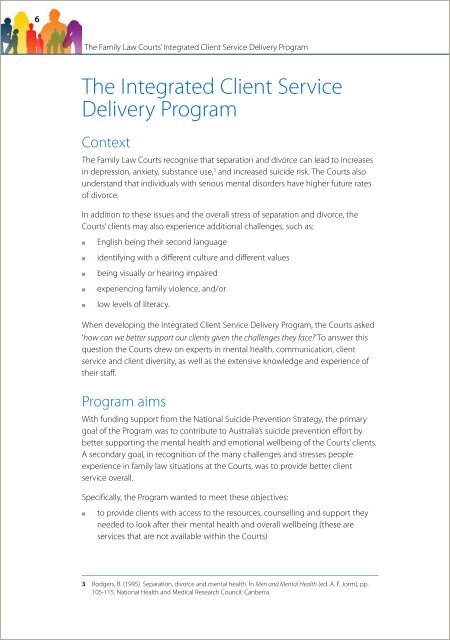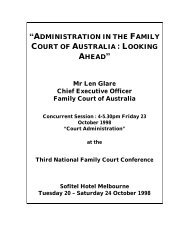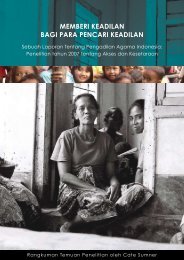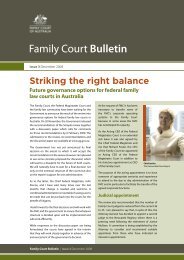Integrated client service delivery, featuring mental health support ...
Integrated client service delivery, featuring mental health support ...
Integrated client service delivery, featuring mental health support ...
You also want an ePaper? Increase the reach of your titles
YUMPU automatically turns print PDFs into web optimized ePapers that Google loves.
6The Family Law Courts’ <strong>Integrated</strong> Client Service Delivery ProgramThe <strong>Integrated</strong> Client ServiceDelivery ProgramContextThe Family Law Courts recognise that separation and divorce can lead to increasesin depression, anxiety, substance use, 3 and increased suicide risk. The Courts alsounderstand that individuals with serious <strong>mental</strong> disorders have higher future ratesof divorce.In addition to these issues and the overall stress of separation and divorce, theCourts’ <strong>client</strong>s may also experience additional challenges, such as:nnnnnEnglish being their second languageidentifying with a different culture and different valuesbeing visually or hearing impairedexperiencing family violence, and/orlow levels of literacy.When developing the <strong>Integrated</strong> Client Service Delivery Program, the Courts asked‘how can we better <strong>support</strong> our <strong>client</strong>s given the challenges they face?’ To answer thisquestion the Courts drew on experts in <strong>mental</strong> <strong>health</strong>, communication, <strong>client</strong><strong>service</strong> and <strong>client</strong> diversity, as well as the extensive knowledge and experience oftheir staff.Program aimsWith funding <strong>support</strong> from the National Suicide Prevention Strategy, the primarygoal of the Program was to contribute to Australia’s suicide prevention effort bybetter <strong>support</strong>ing the <strong>mental</strong> <strong>health</strong> and emotional wellbeing of the Courts’ <strong>client</strong>s.A secondary goal, in recognition of the many challenges and stresses peopleexperience in family law situations at the Courts, was to provide better <strong>client</strong><strong>service</strong> overall.Specifically, the Program wanted to meet these objectives:n to provide <strong>client</strong>s with access to the resources, counselling and <strong>support</strong> theyneeded to look after their <strong>mental</strong> <strong>health</strong> and overall wellbeing (these are<strong>service</strong>s that are not available within the Courts)3 Rodgers, B. (1995). Separation, divorce and <strong>mental</strong> <strong>health</strong>. In Men and Mental Health (ed. A. F. Jorm), pp.105-115. National Health and Medical Research Council: Canberra.
















